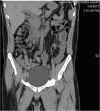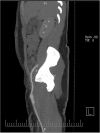Massive hematuria due to an autogenous saphenous vein graft and urinary bladder fistula in an extra-anatomic iliofemoral bypass: a case report
- PMID: 31812163
- PMCID: PMC6899332
- DOI: 10.1186/s13256-019-2300-8
Massive hematuria due to an autogenous saphenous vein graft and urinary bladder fistula in an extra-anatomic iliofemoral bypass: a case report
Abstract
Introduction: Gross hematuria caused by rupture of an artery in the urinary tract is a rare but potentially fatal condition. Iliac artery aneurysms, pelvic surgery with radiation, vascular reconstructive surgery, surgery for stenosis of the ureteropelvic junction, and transplantation are reported to be associated with this condition. In the vascular reconstructive surgery group, the most common etiology is rupture of the degenerated artery or synthetic graft in the ureter.
Case presentation: We present a case of rupture of the small anastomotic pseudoaneurysm at the proximal anastomosis of a right iliofemoral autogenous vein extra-anatomic graft in the urinary bladder. To our knowledge, this is the first report of a rupture of an autogenous vein graft in the urinary bladder. Our patient, a 24-year-old Albanian farmer, was admitted to the emergency department in severe hemorrhagic shock induced by exsanguinating hematuria. He underwent immediate surgery, during which direct sutures to the bladder were placed and the saphenous graft was replaced with a synthetic one. The patient recovered completely, was free of hematuria, and showed no signs of pathological communication between the urinary and arterial tracts on postoperative cystoscopy and computed tomographic angiography during 2 years of follow-up.
Conclusion: The incidence of artery-to-urinary tract fistulas is growing due to the increasing use of urologic and vascular surgery, pelvic oncologic surgery, and radiation therapy. In addition to fistulas involving a degenerated artery and ureter or synthetic grafts and ureter, they can also involve an autogenous vein graft and the urinary bladder. In our patient, the fistula was a result of erosion of the bladder from a pseudoaneurysm at the proximal anastomosis of an autogenous vein iliofemoral bypass in an extra-anatomic position. Open surgery remains the best treatment option, although there is increasing evidence of successful endovascular treatment.
Keywords: Autogenous vein graft to urinary bladder fistula; Extra-anatomic bypass; Massive hematuria.
Conflict of interest statement
The authors declare that they have no competing interests.
Figures






Similar articles
-
The Debatable Choice of Iliac Inflow Source for Redo Femoropopliteal and Infrapopliteal Bypass.Ann Vasc Surg. 2018 Oct;52:316.e15-316.e19. doi: 10.1016/j.avsg.2018.04.013. Epub 2018 Jun 8. Ann Vasc Surg. 2018. PMID: 29886210
-
Crossover iliofemoral bypass graft through tension-free abdominal wall-repair mesh.Ann Ital Chir. 2017;6:433-437. Ann Ital Chir. 2017. PMID: 28632147
-
Revascularization for iliac-femoral artery pseudoaneurysm with greater saphenous vein.Chin Med Sci J. 2010 Mar;25(1):57-60. doi: 10.1016/s1001-9294(10)60022-3. Chin Med Sci J. 2010. PMID: 20449956
-
[Treatment of radiation-induced iliofemoral arterial complications with groin radionecrosis].J Med Vasc. 2017 Dec;42(6):358-366. doi: 10.1016/j.jdmv.2017.09.004. Epub 2017 Nov 1. J Med Vasc. 2017. PMID: 29203042 Review. French.
-
Iliac Artery-Uretero-Colonic Fistula Presenting as Severe Gastrointestinal Hemorrhage and Hematuria: A Case Report and Review of the Literature.Ann Vasc Surg. 2015 Nov;29(8):1656.e1-6. doi: 10.1016/j.avsg.2015.07.006. Epub 2015 Aug 22. Ann Vasc Surg. 2015. PMID: 26303272 Review.
References
-
- Sountoulides P, Zachos I, Paschalidis K, Asouhidou I, Fotiadou A, Bantis A, Palasopoulou M, Podimatas T. Massive hematuria due to a congenital renal arteriovenous malformation mimicking a renal pelvis tumor: a case report. J Med Case Rep. 2008;2:144. doi: 10.1186/1752-1947-2-144. - DOI - PMC - PubMed
Publication types
MeSH terms
LinkOut - more resources
Full Text Sources

